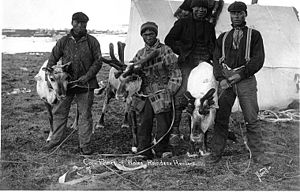

Alaska Reindeer Service (ARS) was established for the benefit of the U.S. territory of Alaska by Congressional action on March 3, 1893. The ARS was an integral part of the educational system of northern and western Alaska. The superintendent of education of Alaska Natives had general supervision of the work. The district superintendents in northern and western Alaska were supervisors of the reindeer industry within their districts. The first annual expenditure for the period of 1893-94 was US$5,998.[1]
The establishment of the ARS was the earliest Governmental action providing, by the introduction of a new industry, practical vocational training adapted to community needs, guaranteeing assured support, and resulting in training indigenous peoples into independence.[2] The purpose of the ARS was to accomplish the general distribution of the reindeer among the villages as rapidly as the Inupiat and Yupiit could be trained, by means of a system of apprenticeship, to care for and use the reindeer, resulting in the ultimate establishment of the reindeer enterprise upon a self-supporting basis,[3] for the Inupiat of the Seward Peninsula.[4] "Sheldon Jackson commissioned Sami herders from Norway to move to Alaska and teach apprentice Alaska Natives herding techniques, such as driving and milking reindeer, building and using corrals, marking ears, and working herding dogs."[4]
The ARS affected a vast area: the northernmost station was Point Barrow; the southernmost station was at Ugashik; the westernmost station was near Cape Prince of Wales; and the easternmost station was at Tanana.[3]
- ^ Committee on the Territories 1921, p. 70.
- ^ Committee on the Territories 1921, p. 540.
- ^ a b Bureau of Education 1886, p. 1364.
- ^ a b "U.S. Reindeer Service". University of Alaska Fairbanks. 20 January 2016. Retrieved 4 July 2016.